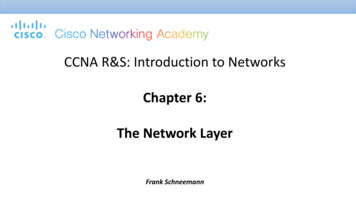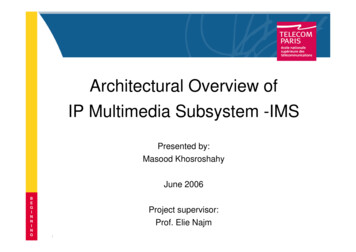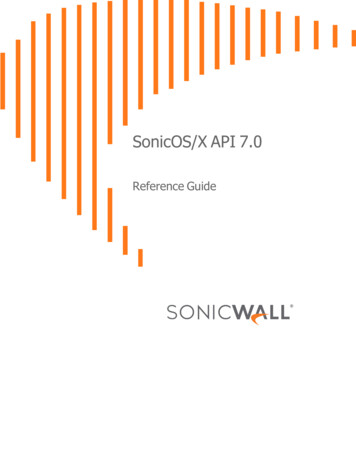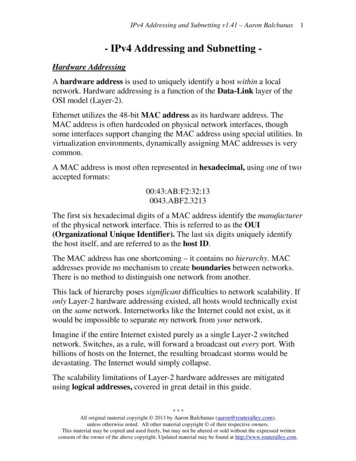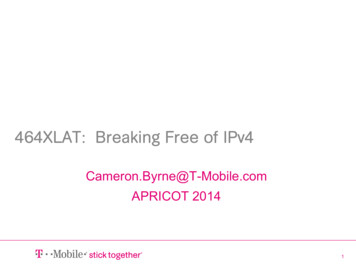
Transcription
464XLAT: Breaking Free of IPv4Cameron.Byrne@T-Mobile.comAPRICOT 20141
Background T-Mobile US is a GSM / UMTS / LTE provider in the USA with 45 Million subscribers In 2008, T-Mobile launched the first Android phone. This dramaticallychanged the mobile data dynamics – more devices, connected for alonger time, all needing IP addresses T-Mobile embraced the concept of IPv6-only, since dual-stackrequired IPv4 that was not available NAT64 / DNS64 was a good solution that did not require IPv4 oneach client, but some applications failed to work on IPv6-onlynetworks. It is not acceptable to break Skype or Netflix, applicationsthat require IPv4 T-Mobile, in partnership with NEC and JPIX, documented 464XLAT inthe IETF as RFC6877 to overcome the limitations of NAT64 byadding a NAT46 into the client (CLAT) Android 4.3 introduced support for 464XLAT in October 20132
Results Are Important T-Mobile US launched 5 Android phones with 464XLAT as the defaultin the last 5 months, all Android 4.3 phones will be 464XLAT in thefuture at T-Mobile US 3.6 million unique IPv6 subscribers in the first 5 months are active onthe network http://www.worldipv6launch.org/measurements/ measurements show15.76% of all T-Mobile connections are now IPv6, as of February 21,2014 Over 50% of IPv6-user traffic is end-to-end IPv6 (no translationneeded) This saves money and makes the network simpler3
15.76 of T-Mobile US Connections use 464XLAT4
Default 464XLAT Phones at T-Mobile USSamsungNote 3Google / LGNexus 5SamsungMega5
464XLAT PhonesGalaxy LightSony Z1s6
464XLAT allows for full functionality onIPv6-only networks Dual-stack does not solve the IPv4 number scarcityissue IPv6-only NAT64/DNS64 is very good, but not goodenough for full IPv4 replacement (web and email work,but Skype does not work) IPv6-only 464XLAT Solves IPv4 numbering issue by not assigning IPv4 to clients Decouples edge growth from IPv4 availability IPv4-only applications like Skype work on an IPv6-only networkbecause 464XLAT translates IPv4 on the phone to IPv6 on thenetwork7
IPv6 deployment is easy achievable T-Mobile USA did not spend any CapEx on IPv6 Innovative thinking helps reduce deployment costs (hash128 bit numbers into 32 bit fields in billing records) IPv6 will save money in your network (less NAT/CGN,no need to buy IPv4 addresses, )Only introduce 464XLAT on new phones, so we do notdisrupt any existing services8
In fact, with roaming, we can show Chunghwain Taiwan and MY MAXIS in Malaysia supportIPv6 today in the Radio Access Network (RAN)9
Which Platforms Supports 464XLAT Today?YESNOAndroid 4.3 BlackberryAppleWindows Phone (?)10
IMPORTANT! Anything that is natively IPv6 enabled does not requireany sort of translation, 464XLAT is idle and transparentfor any IPv6 end-to-end flow IPv6 end-to-end just works! As more and more services transition to IPv6, 464XLATis engaged less and less 464XLAT is an IPv4 EXIT STRATEGY464XLAT is only for service and applications that areusing LEGACY IPV411
THE TECHNICAL DETAILS12
464XLAT is just a set of building blocks Stateless NAT64 (RFC6145) Statefull NAT64 (RFC6146) Provider site translation PLATDNS64 (RFC 6147) Client side translation CLATWhen the FQDN does not have a AAAA record, DNS64dynamically creates one that allows the client to use IPv6 andthe network translates from IPv6 to IPv4 at the NAT64Prefix64 Discovery (RFC 7050) Queries for the well-known FQDN ipv4only.arpa, which is bydefinition IPv4-only. If there is a AAAA response provided, thenit is known that a DNS64 is in the path13
3 Scenarios in 464XLAT1. End-to-end IPv6: Facebook, Google, Wikipedia, Yahoo,Youtube IPv6- IPv62. Application supports IPv6 (web browser) but the serveris only IPv4 (www.amazon.com, www.myspace.com, ), so DNS64/NAT64 translates IPv6- IPv43. Application does not support IPv6 (Skype, Whatsapp, ), the client must provide a stateless NAT46 to theapplication and stateful NAT64 must be in the network:IPv4- IPv6- IPv414
How does Stateless NAT64 work? Algorithmically map IPv4 addresses to IPv6addresses, bidirectional, 1 to 1 Not dynamicDeterministicMaps all of IPv4’s 32 bits into an IPv6 /96 (or larger prefix) Defined in RFC6145 Example 2001:db8::10.1.1.1 - 10.1.1.12001:db8::10.2.2.2 - 10.2.2.22001:db8::www.example.com - ipv4 www.example.com15
How does Stateful NAT64 work? Dynamically translate IPv6 packets to IPv4 packets DynamicNot deterministic (translation based on available IPv4 pool)Translation state is short-lived and based on session creationand termination Defined in RFC6146 Example Before translation TCP source 2001:db8:abcd::ffff port 555 # client addressTCP destination 2001:db8:1234::10.1.1.1 port 80 # NAT64addressAfter translation TCP source 192.168.1.1 port 555 # 192.168.1.1 availablefrom NAT64 pool TCP destination 10.1.1.1 port 80 # Last 32 bits of IPv6destination16
How does DNS64 work? When an FQDN does not have a AAAA record, theDNS64 will synthetically create one based on a networkdefined Pref64 The pref64 is a prefix hosted on the NAT64 fortranslation Example without DNS64 Query a and aaaa for www.example.com Answer a 10.1.1.1, aaaa NO ERRORExample with DNS64 Query a and aaaa for www.example.com Answer a 10.1.1.1 AND aaaa 2001:db8::10.1.1.1 17
How is the Pref64 discovered on theclient? Pref64 is topologically located on the NAT64 Automatic discovery of Pref64 is defined in RFC 7050The DNS64 forces clients to send traffic to the NAT64for translation from IPv6 to IPv4The client will lookup the well-known FQDNipv4only.arpa. If a AAAA record is presented for thiswell-know IPv4-only FQDN, the clientcan parse theresponse to find the Pref64 used within this network18
Pref64 Configuration Information Flow19
How to make EVERYTHING work on IPv6-only?20
Zoom Out: What does this look like inthe context of 3GPP GSM / UMTS /LTE ?21
High Level View of IPv6 deployment:Phone, HLR profile, GGSN, NAT64, IPv6 ISP22
Impact to Network EntitiesPer subscriber PDPType to be changed toIPv6Dual Stack UE capableof IPv4 and IPv6Generate IPv6 AAAArecord from IPv4 ArecordUsed for accessing IPv4 content onInternet. Constructs IPv4 addresses fromlast 32 bits of IPv6 addressHLRNo ChangeSGSNRANNo ChangeIP Backbone‘IPv6 on User Plane’feature to be activatedDNS 64GGSNIPv4ContentNAT64Test APN setting to bechanged to allocateIPv6 addressesInternetIPv6Content23
Zoom in: What does the defaultAndroid configuration look like?:clatd.conf24
Zoom in: What does the phoneconfiguration look like: APN SettingsIn Android 4.3,“APN ProtocolIPv6” for the “APNType default”triggers the use of464XLAT bydefaultIPv6 464XLAT25
TIME FOR WIRESHARK26
Like most things, we start with DNS The client is IPv6-only towards the network, but the hostOS thinks it is dual-stack since it has an IPv4 CLATinterface and a native IPv6 radio interface So, the client does a query for DNS “A” and “AAAA”records The DNS64 responds with a synthesized AAAA and thereal A The synthesized AAAA Pref64 real IPv427
Quick Check Does the synthesized AAAA match the pref64 real A?pref64Real IPv428
Next, the UE selects the IPv6 DNSresponse, and starts TCP From the client perspective, this is a native IPv6 end-toend flow But, we know that the DNS is a synthesized AAAA and theclient is actually sending its packets to the NAT64 for IPv6 IPv4 stateful translation This is just DNS64 / NAT64, no client-side translationneeded for this scenario29
The full case of 464XLAT doubletranslation: WhatsApp30
SYN is sent from the CLAT addressRemember, we set the clatd.conf to use the IID of ::464for CLAT translations31
The MMS situation The Android MMS function communicates directly to themodem and by-passes the normal OS networking stack Frequently MMS is its own APN Solutions Use an FQDN, DNS64 still works fine If you cannot use an FQDN, manually use a NAT64 literalThis means 464XLAT is bypassed, 464XLAT only workson the default APN, not special APNs like SUPL andMMSinstead of the IPv4 literal (pref64 ipv4 literal)32
Security: Follow the rule of leastprivilege Filter access to the DNS severFilter access to the Pref64 on the NAT64Using ULA Pref64 will NOT work well since Androidprefers IPv4 over IPv6 ULA. This results in 100% CLATtranslations for IPv4 resources33
Summary IPv4 does not fit the business needs to grow the edge of ournetworks fueled by growth from internet of things and cloud IPv6 works today and is deployed on some of the largestedge networks 464XLAT allows networks to grow without many public IPv4addresses IPv6 deployment in 3GPP GSM / UMTS /LTE is achievabletodayBig Picture: We must avoid the Internet’s largest growthengine (mobile) from being indefinitely tied to scarce IPv4and fragile stateful NAT44.34
longer time, all needing IP addresses T-Mobile embraced the concept of IPv6-only, since dual-stack required IPv4 that was not available NAT64 / DNS64 was a good solution that did not require IPv4 on each client, but some applications failed to work on IPv6-only networks. It is not acceptable to break Skype or Netflix, applications
